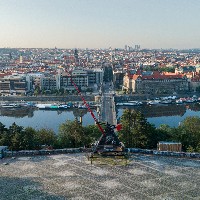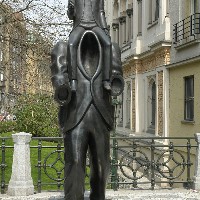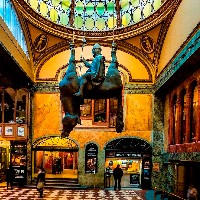Breadcrumbs navigation
Contemporary art in public spaces
You can venture beyond galleries and museums to find the visual arts. Prague is itself one big open-air gallery, with monuments and statues practically ‘at every turn’. Think of the Baroque statues on Charles Bridge, the statue of St Wenceslas (1912) on Wenceslas Square, the monumental statue of Jan Hus (1915) on Old Town Square or the equestrian statue of Jan Žižka (1950) on Vítkov Hill.
Allow us to draw your attention to a few interesting contemporary things to see:
Memorial to the Victims of Communism – at the foot of Petřín slope opposite Vítězná street is one of the most unusual memorials in Prague, by sculptor Olbram Zoubek. The Memorial consists of a narrow stairway, with seven bronze male figures ascending. The first statue is intact, each behind progressively less so. The sculptor thus depicted the escalating suffering of political prisoners in 1950s Communist Czechoslovakia.
The Metronome on Letná (by Vratislav Novák), aka the Time Machine, stands atop Prague in a symbolic place. It was here that a gigantic statue of Stalin once towered into the sky, dynamited away in 1962. The Metronome symbolizes the unstoppable passage of time and its location also warns against a repeat of our tragic past. From the Metronome you’ll get breath-taking views of the Old Town and the Vltava river and its bridges.
The Václav Havel Bench (by Bořek Šípek) – two chairs and a bench around the trunk of a Linden tree on Maltézské square are dedicated to former Czech President Václav Havel. The site is intended not only for relaxation but also to commemorate this important figure of Czech and international history. There are benches just like it in Washington and Dublin.
Statue of Franz Kafka in Dušní Street (by Jaroslav Róna) – a two-figure sculpture consisting of two bodies – the lower massive figure is a hollow suit (jacket and trousers), and on its shoulders sits Franz Kafka himself. The memorial is inspired by Kafka’s short story Description of a Struggle.
The Sculpture Garden of the Convent of St Agnes of Bohemia following its recent revitalization is teeming with sculptures by contemporary Czech artists such as Jaroslav Róna, Stefan Milkov, Stanislav Kolíbal or originals by František Skála. Admission is free.
The Lennon Wall – a brightly painted wall symbolizes the tomb of the legendary Beatle and peaceful resistance to violence worldwide. It was created just after the death of Lennon at the end of 1980, when people began spontaneously adding graffiti to mark his life and thoughts, laying flowers and candles. To this day the wall attracts new graffiti, the original painting with the portrait of John Lennon lost beneath layers of paint.
David Černý is one of the most closely watched Czech artists, whose installations in Prague streets still stir up emotions. His works are, however – undeniably quirky, often ironically pungent and thought-provoking.
David Černý gained recognition with his sculpture of a walking Trabant called Quo Vadis. It symbolized the mass exodus of thousands of former East Germans to West Germany through its embassy during the summer and autumn of 1989. In 1990 the sculpture was shown on Old Town Square, and today its bronze casting is a fixture at the German Embassy in the Lesser Town, readily accessible to the public.
The otherwise inconspicuous Husova street in the Old Town features an over 2m high statue of Sigmund Freud, suspended from the roof of one of the houses. This, called Hanging Out, depicts the artist’s sense of entering into the new millennium and the odd end of the last one.
Probably the most photographed of Černý’s works is the dead Horse hanging from the Lucerna mall ceiling, just a few dozen yards from the iconic Statue of St Wenceslas by Myslbek, which it complements. Černý has his St Wenceslas sitting astride the horse’s belly. The dead horse hanging tied up by the hooves with his tongue out is a highly popular tourist draw.
The Žižkov Television Tower has since 2001 faced its invasion of so-called Babies. 10 monstrous fibreglass figural sculptures are mischievously scaling up and down the façade, defying gravity. Visually matching toddlers can be seen by Museum Kampa.
Latterly grabbing attention the most is a kinetic sculpture of Franz Kafka, composed of 42 moving tiers that rotate independently of each other and constantly transform Kafka’s face.
Text and photo: Prague City Tourism







